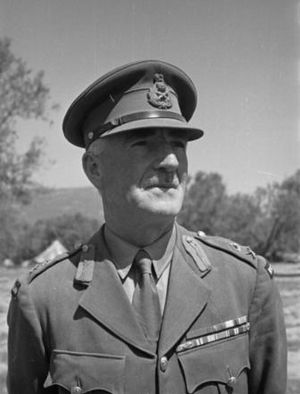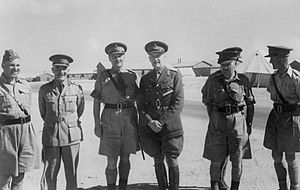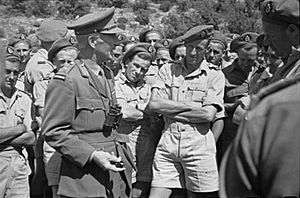Edward Puttick facts for kids
Quick facts for kids
Sir Edward Puttick
|
|
|---|---|

Lieutenant General Edward Puttick in Italy, May 1944
|
|
| Born | 26 June 1890 Timaru, New Zealand |
| Died | 25 July 1976 (aged 86) Hamilton, New Zealand |
| Buried |
Karori Cemetery, Wellington, New Zealand
|
| Allegiance | New Zealand |
| Service/ |
New Zealand Military Forces |
| Years of service | 1911–46 |
| Rank | Lieutenant General |
| Commands held | Chief of the General Staff (1941–45) 2nd New Zealand Division (1941) 4th Infantry Brigade (1939–41) Central Military District (1939) Fiji Expeditionary Force (1920) 3rd Battalion, New Zealand Rifle Brigade (1917–18) 1st Battalion, New Zealand Rifle Brigade (1917) |
| Battles/wars | First World War
Second World War
|
| Awards | Knight Commander of the Order of the Bath Distinguished Service Order & Bar Mentioned in Despatches (3) |
Lieutenant General Sir Edward Puttick (26 June 1890 – 25 July 1976) was a brave officer from New Zealand. He served in both the First World War and the Second World War. He was the first soldier born in New Zealand to reach the very high rank of lieutenant general. From 1941 to 1945, he was the Chief of the General Staff for the New Zealand Military Forces, which means he was in charge of the entire army.
Born in Timaru in 1890, Puttick was part of the Territorial Force before the First World War. In 1914, he joined a special force that took control of German Samoa. Later, he fought with the New Zealand Rifle Brigade in the Senussi campaign and on the Western Front in Europe. He was wounded in 1918 and sent back to New Zealand.
After the First World War, Puttick joined the New Zealand Staff Corps and held many important leadership roles. During the Second World War, he led the 4th Infantry Brigade in the Battle of Greece. For his bravery there, he received another medal, a bar to his Distinguished Service Order. After the Allies left Greece, he commanded the 2nd New Zealand Division during the Battle of Crete. In September 1941, he returned to New Zealand to become the Chief of General Staff. He held this top position until late 1945. He retired from the army in 1946 and passed away in 1976.
Contents
Early Life and Joining the Army
Edward Puttick was born in Timaru, New Zealand. His father worked for the railway. Edward went to Waitaki Boys' High School. After school, he worked for the Roads Department, where he drew plans.
In 1911, he joined the new Territorial Force. This was like a part-time army for New Zealanders. He started as a second lieutenant. The next year, he moved to Wellington and joined a different regiment.
First World War Experiences
When the First World War started in 1914, Edward Puttick's unit was sent to German Samoa. He was a captain and landed there on August 29. They took control of Samoa without any fighting. He stayed there for several months before coming back to New Zealand in April 1915.
Back home, he volunteered to join the New Zealand Expeditionary Force (NZEF). This was the main New Zealand army sent overseas. He went to Egypt and joined the 1st Battalion, New Zealand Rifle Brigade.
Fighting in Egypt and France
From January to February 1916, Puttick led a company during the Senussi Campaign in North Africa. After that, he joined the 2nd Infantry Brigade as a major. In April, he went with his division to the Western Front in France. This was where much of the fighting happened in Europe.
In July, he moved back to the Rifle Brigade. He became the second-in-command of its 4th Battalion. He fought in the Battle of Flers-Courcelette in September 1916. He was praised for his leadership during this battle. In December, he temporarily led the 4th Battalion.
In June 1917, he again took temporary command of the battalion during the Battle of Messines. He then led the battalion through the Battle of Passchendaele until November 1917. Later that year, he was again mentioned for his brave actions. On January 1, 1918, he received the Distinguished Service Order (DSO) for his service.
Wounded in Action
On March 21, 1918, the Germans launched a big attack called the Spring Offensive. Puttick's division was sent to a dangerous area near Colincamps. On March 27, he was wounded in the chest while leading his battalion. He was sent to England for treatment. After getting better, he helped train soldiers at a camp. However, his wounds were serious, so he was sent back to New Zealand when the war ended.
Between the Wars
After returning to New Zealand, Edward Puttick married Irene Lillian Dignan. They had three daughters. He worked for the Roads Department again for a short time. In 1919, he joined New Zealand's full-time army as a major.
In 1920, Puttick was put in charge of the Fiji Expeditionary Force. This small group of about 55 soldiers went to Fiji to help the local police with workers' issues. They stayed there for two months.
Over the next 20 years, he held many important jobs in the army. He went to England for advanced military training in 1937. He also represented New Zealand at the coronation of King George VI and Queen Elizabeth in London. By 1938, he was in charge of army administration and supplies.
Second World War Leadership
When the Second World War began, Puttick was in charge of the Central Military District in New Zealand. He played a big part in getting the Second New Zealand Expeditionary Force (2NZEF) ready to go overseas. He was promoted to temporary brigadier and commanded the 4th Infantry Brigade. This was the first brigade of the new 2nd New Zealand Division, led by Major General Bernard Freyberg. The brigade left for Egypt in January 1940.

Puttick trained his brigade in Egypt. In June 1940, he temporarily commanded all New Zealand forces in Egypt. In April 1941, his division was sent to Greece to help fight the Germans. He led his brigade well during the Battle of Greece. They had to retreat and were evacuated to Crete on April 27. For his bravery and dedication, he received a Bar to his DSO medal.
On Crete, Puttick was promoted to temporary major general. He took command of the 2nd New Zealand Division. During the Battle of Crete, the Allies lost control of Maleme airfield to the Germans. This made it easier for the Germans to bring in more soldiers and supplies. The Allies eventually had to leave Crete.
After returning to Egypt, Puttick was asked to become the Chief of the General Staff for New Zealand. This meant he would be the top commander of the New Zealand Army. He accepted and returned to New Zealand in September 1941. His main job was to make sure enough new soldiers were sent to the 2NZEF fighting in North Africa.
When Japan entered the war, Puttick also worked hard to improve New Zealand's defenses. He thought a full invasion was unlikely, but he still encouraged better home defense to keep people's spirits up.
In April 1942, Puttick was promoted to lieutenant general. He was the first New Zealand-born soldier to reach this rank. He also received another honor, becoming a Companion of the Order of the Bath (CB). As the war continued, he had to manage resources carefully. He needed to support both the 2nd New Zealand Division in the Middle East and the 3rd New Zealand Division fighting in the Pacific. Later in the war, he believed it was more important to keep the 2nd Division in Italy to help defeat Germany.
Later Life and Legacy
Major General Norman Weir took over as Chief of the General Staff in late 1945. In 1946, Edward Puttick was made a Knight Commander of the Order of the Bath, which meant he was now called "Sir Edward." In June 1946, he led the New Zealand group at the Victory Parade in London. He retired from the army three months later.
After retiring, Sir Edward Puttick wrote a book about the 25th Battalion, which was part of the Official History of New Zealand in the Second World War 1939–45. His wife passed away in 1964. In his later years, he lived in Raglan, a small town by the sea. He died on July 25, 1976, in Hamilton. He was buried with military honors at Karori Cemetery in Wellington.


